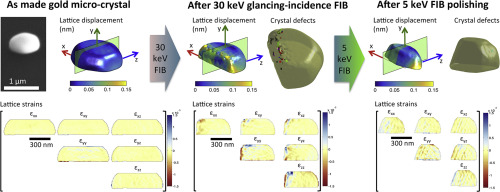当前位置:
X-MOL 学术
›
Acta Mater.
›
论文详情
Our official English website, www.x-mol.net, welcomes your
feedback! (Note: you will need to create a separate account there.)
Glancing-Incidence Focussed Ion Beam Milling: A Coherent X-ray Diffraction Study of 3D Nano-scale Lattice Strains and Crystal Defects
Acta Materialia ( IF 8.3 ) Pub Date : 2018-08-01 , DOI: 10.1016/j.actamat.2018.05.018 Felix Hofmann , Ross J. Harder , Wenjun Liu , Yuzi Liu , Ian K. Robinson , Yevhen Zayachuk
Acta Materialia ( IF 8.3 ) Pub Date : 2018-08-01 , DOI: 10.1016/j.actamat.2018.05.018 Felix Hofmann , Ross J. Harder , Wenjun Liu , Yuzi Liu , Ian K. Robinson , Yevhen Zayachuk

|
This study presents a detailed examination of the lattice distortions introduced by glancing incidence Focussed Ion Beam (FIB) milling. Using non-destructive multi-reflection Bragg coherent X-ray diffraction we probe damage formation in an initially pristine gold micro-crystal following several stages of FIB milling. These experiments allow access to the full lattice strain tensor in the micro-crystal with ~25 nm 3D spatial resolution, enabling a nano-scale analysis of residual lattice strains and defects formed. Our results show that 30 keV glancing incidence milling produces fewer large defects than normal incidence milling at the same energy. However the resulting residual lattice strains have similar magnitude and extend up to ~50 nm into the sample. At the edges of the milled surface, where the ion-beam tails impact the sample at near-normal incidence, large dislocation loops with a range of burgers vectors are formed. Further glancing incidence FIB polishing with 5 keV ion energy removes these dislocation loops and reduces the lattice strains caused by higher energy FIB milling. However, even at the lower ion energy, damage-induced lattice strains are present within a ~20 nm thick surface layer. These results highlight the need for careful consideration and management of FIB damage. They also show that low-energy FIB-milling is an effective tool for removing FIB-milling induced lattice strains. This is important for the preparation of micro-mechanical test specimens and strain microscopy samples.
中文翻译:

掠入射聚焦离子束铣削:3D 纳米级晶格应变和晶体缺陷的相干 X 射线衍射研究
本研究详细介绍了由掠入射聚焦离子束 (FIB) 铣削引入的晶格畸变。使用非破坏性多反射布拉格相干 X 射线衍射,我们在 FIB 铣削的几个阶段后探测初始原始金微晶中的损伤形成。这些实验允许访问具有 ~25 nm 3D 空间分辨率的微晶中的完整晶格应变张量,从而能够对形成的残余晶格应变和缺陷进行纳米级分析。我们的结果表明,在相同能量下,30 keV 掠入射铣削比垂直入射铣削产生的大缺陷更少。然而,由此产生的残余晶格应变具有相似的幅度,并延伸至样品中约 50 nm。在铣削表面的边缘,在离子束尾部以接近垂直的入射角撞击样品的地方,形成了具有一系列汉堡矢量的大位错环。使用 5 keV 离子能量的进一步掠入射 FIB 抛光去除了这些位错环并减少了由更高能量 FIB 研磨引起的晶格应变。然而,即使在较低的离子能量下,约 20 nm 厚的表面层内也存在损伤诱导的晶格应变。这些结果强调需要仔细考虑和管理 FIB 损伤。他们还表明,低能 FIB 铣削是消除 FIB 铣削引起的晶格应变的有效工具。这对于制备微机械试样和应变显微镜样品很重要。使用 5 keV 离子能量的进一步掠入射 FIB 抛光去除了这些位错环并减少了由更高能量 FIB 研磨引起的晶格应变。然而,即使在较低的离子能量下,约 20 nm 厚的表面层内也存在损伤诱导的晶格应变。这些结果强调需要仔细考虑和管理 FIB 损伤。他们还表明,低能 FIB 铣削是消除 FIB 铣削引起的晶格应变的有效工具。这对于制备微机械试样和应变显微镜样品很重要。使用 5 keV 离子能量的进一步掠入射 FIB 抛光去除了这些位错环并减少了由更高能量 FIB 研磨引起的晶格应变。然而,即使在较低的离子能量下,约 20 nm 厚的表面层内也存在损伤诱导的晶格应变。这些结果强调需要仔细考虑和管理 FIB 损伤。他们还表明,低能 FIB 铣削是消除 FIB 铣削引起的晶格应变的有效工具。这对于制备微机械试样和应变显微镜样品很重要。这些结果强调需要仔细考虑和管理 FIB 损伤。他们还表明,低能 FIB 铣削是消除 FIB 铣削引起的晶格应变的有效工具。这对于制备微机械试样和应变显微镜样品很重要。这些结果强调需要仔细考虑和管理 FIB 损伤。他们还表明,低能 FIB 铣削是消除 FIB 铣削引起的晶格应变的有效工具。这对于制备微机械试样和应变显微镜样品很重要。
更新日期:2018-08-01
中文翻译:

掠入射聚焦离子束铣削:3D 纳米级晶格应变和晶体缺陷的相干 X 射线衍射研究
本研究详细介绍了由掠入射聚焦离子束 (FIB) 铣削引入的晶格畸变。使用非破坏性多反射布拉格相干 X 射线衍射,我们在 FIB 铣削的几个阶段后探测初始原始金微晶中的损伤形成。这些实验允许访问具有 ~25 nm 3D 空间分辨率的微晶中的完整晶格应变张量,从而能够对形成的残余晶格应变和缺陷进行纳米级分析。我们的结果表明,在相同能量下,30 keV 掠入射铣削比垂直入射铣削产生的大缺陷更少。然而,由此产生的残余晶格应变具有相似的幅度,并延伸至样品中约 50 nm。在铣削表面的边缘,在离子束尾部以接近垂直的入射角撞击样品的地方,形成了具有一系列汉堡矢量的大位错环。使用 5 keV 离子能量的进一步掠入射 FIB 抛光去除了这些位错环并减少了由更高能量 FIB 研磨引起的晶格应变。然而,即使在较低的离子能量下,约 20 nm 厚的表面层内也存在损伤诱导的晶格应变。这些结果强调需要仔细考虑和管理 FIB 损伤。他们还表明,低能 FIB 铣削是消除 FIB 铣削引起的晶格应变的有效工具。这对于制备微机械试样和应变显微镜样品很重要。使用 5 keV 离子能量的进一步掠入射 FIB 抛光去除了这些位错环并减少了由更高能量 FIB 研磨引起的晶格应变。然而,即使在较低的离子能量下,约 20 nm 厚的表面层内也存在损伤诱导的晶格应变。这些结果强调需要仔细考虑和管理 FIB 损伤。他们还表明,低能 FIB 铣削是消除 FIB 铣削引起的晶格应变的有效工具。这对于制备微机械试样和应变显微镜样品很重要。使用 5 keV 离子能量的进一步掠入射 FIB 抛光去除了这些位错环并减少了由更高能量 FIB 研磨引起的晶格应变。然而,即使在较低的离子能量下,约 20 nm 厚的表面层内也存在损伤诱导的晶格应变。这些结果强调需要仔细考虑和管理 FIB 损伤。他们还表明,低能 FIB 铣削是消除 FIB 铣削引起的晶格应变的有效工具。这对于制备微机械试样和应变显微镜样品很重要。这些结果强调需要仔细考虑和管理 FIB 损伤。他们还表明,低能 FIB 铣削是消除 FIB 铣削引起的晶格应变的有效工具。这对于制备微机械试样和应变显微镜样品很重要。这些结果强调需要仔细考虑和管理 FIB 损伤。他们还表明,低能 FIB 铣削是消除 FIB 铣削引起的晶格应变的有效工具。这对于制备微机械试样和应变显微镜样品很重要。











































 京公网安备 11010802027423号
京公网安备 11010802027423号